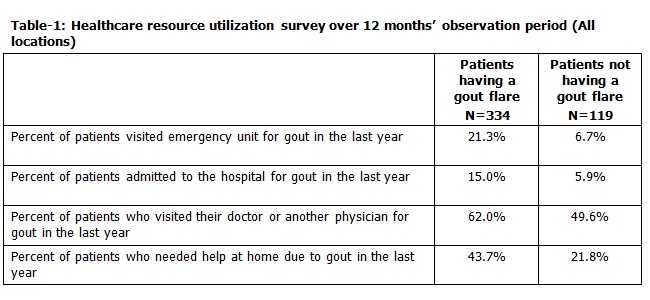Background/Purpose: Refractory gouty arthritis (RGA) is a condition characterized by appearance of recurrent flares and contraindication, intolerance, or lack of efficacy to first-line anti-inflammatory therapy (NSAIDs/colchicine/steroids) and conventional uric acid lowering therapies (ULT). The objective of the study was to assess the humanistic and economic burden of RGA over 1 year during presence or absence of a flare.
Methods: This 12-month, multinational (6 countries), prospective, observational study investigated the disease impact in patients suffering from RGA who had experienced 3 or more flares in past 12 months. Patients who were enrolled were also refractory to first-line anti-inflammatory therapy (NSAIDs, colchicine, or steroids) or to ULTs. Patients were divided in two groups as per the presence or absence of gout flares. Summary statistics pooled for all visits are presented as mean and SD for continuous variables, and proportions for categorical variables. The utility score derived from the combinations of responses to the five questions of the EuroQol Health Status Questionnaire 5D (EQ-5D) was used as the primary outcome measure. Secondary outcomes included Gout Assessment Questionnaire–Gout Impact Scale (GAQ-GIS) and Healthcare resource utilization (ER visit, hospitalization, physician visit and home care).
Results: A total of 454 eligible patients were enrolled in the study (mean age: 56, males: 86.1%). Patients who were having a flare experienced greater difficulty on all 5 dimensions of the EQ-5D descriptive system and mean EQ-5D utility scores pooled across all the visits were worse for patients having a flare [0.614; 95%CI 0.600, 0.628] as compared to patients without a flare [0.867; 95%CI 0.861, 0.872]. The results for mean EQ-5D VAS scores were lower in patients having a flare [60.7; 95%CI 59.3, 62.1] than patients without a flare [79.5; 95%CI 78.9, 80.1]. The mean GAQ-GIS scores for patients with a gout flare vs. those without a gout flare were higher for various parameters such as overall gout concern [81.27 vs 70.06], medication side effects [59.12 vs 51.26], unmet treatment needs [48.26 vs 37.19], wellbeing during attack [57.32 vs 45.23], and gout concern during attack [63.58 vs 54.09]. Furthermore, higher healthcare utilization was observed in patients experiencing a flare (table 1).
Conclusion: RGA imposes a considerable humanistic and economic and burden. Gout flares were associated with increased healthcare resource utilization and diminished quality of life. These findings suggest unmet medical needs in refractory gout patient population.
Disclosure:
L. Bessette,
Novartis,
2;
F. Lioté,
Novartis, Ipsen, Sanofi,
1,
Novartis, SOBI, Astra-Zeneca, Savient, Ipsen, Menarini, Mayoly-Spindler ,
2,
Novartis, Ipsen, Menarini, Savient, Astra-Zeneca, Mayoly-Spindler,
5;
C. Moragues,
Novartis,
2;
R. Moericke,
Novartis,
2;
Z. Zhiyi,
Novartis,
2;
A. Ferreira,
Novartis Pharma AG, Basel,
3;
P. Lecomte,
Novartis Pharma AG, Basel,
3;
S. Kessabi,
Novartis Pharma AG, Basel,
3;
H. Tian,
Novartis Pharmaceuticals Corporation, East Hanover NJ,
3;
J. A. Singh,
Takeda, Savient, Novartis ,
2,
Savient, Takeda, Regeneron and Allergan,
5.
« Back to 2014 ACR/ARHP Annual Meeting
ACR Meeting Abstracts - https://acrabstracts.org/abstract/burden-of-illness-in-refractory-gouty-arthritis-a-one-year-prospective-multinational-observational-study/

